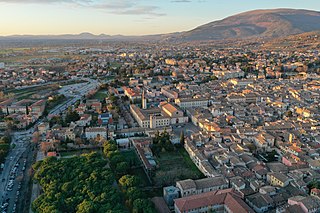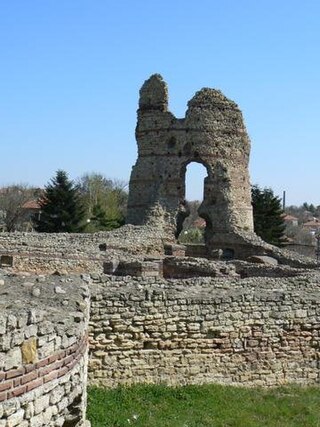
Foligno is an ancient town of Italy in the province of Perugia in east central Umbria, on the Topino river where it leaves the Apennines and enters the wide plain of the Clitunno river system. It is located 40 kilometres south-east of Perugia, 10 km (6 mi) north-north-west of Trevi and 6 km (4 mi) south of Spello.
Fulginiae or Fulginium was an ancient town of Umbria, Italy, on the later line of the Via Flaminia, c. 20 km S of Nuceria.

Krbava is a historical region located in Mountainous Croatia and a former Catholic bishopric (1185–1460), precursor of the diocese of Modruš and present Latin titular see.

Orte is a town, comune, former Catholic bishopric and Latin titular see in the province of Viterbo, in the central Italian region of Lazio, located about 60 kilometres (37 mi) north of Rome and about 24 kilometres (15 mi) east of Viterbo.

Strongoli is a comune and town with a population of over 6000 people in the province of Crotone, in Calabria, southernmost Italy.
Magydus was a city and bishopric of ancient Pamphylia on the Mediterranean coast of southwestern Asia Minor. It is probably the same as Mygdale (Μυγδάλη) described in the Stadiasmus Maris Magni.
Colfiorito is a village in Umbria, central Italy, former Catholic bishopric under its Roman name Plestia, now a frazione of the comune of Foligno and a Latin Catholic titular see.

Felician(us) of Foligno is the patron saint of Foligno.

The Diocese of Nocera Umbra was a Roman Catholic diocese in Umbria, Italy.

The Diocese of Foligno is a Latin Church ecclesiastical territory or diocese of the Catholic Church in Umbria, Italy. It is a suffragan diocese in the ecclesiastical province of the metropolitan Archdiocese of Perugia-Città della Pieve.

The Diocese of Anagni-Alatri is a Latin Church ecclesiastical territory or diocese of the Catholic Church in Lazio, Italy. It has existed in its current form since 1986. In that year the Diocese of Alatri was united to the historical Diocese of Anagni. The diocese is immediately exempt to the Holy See.
Germanicopolis was an ancient town in Bithynia, also known as Caesarea in Bythinia (not to be confused with Caesarea Germanica, as such a former bishopric and present Latin Catholic titular see.

Castra Martis was a Roman fortified garrison (castra) in Dacia which became a town and bishopric and remains a Latin Catholic titular see.
The Diocese of Sisak is a Latin Church diocese in the Sisak-Moslavina region, Croatia. It is a suffragan diocese in the ecclesiastical province of the metropolitan Archdiocese of Zagreb.

Negrine is a town and commune in Tébessa Province in north-eastern Algeria. It was the site of ancient Casae Nigrae, a settlement of Roman North Africa with an attached bishopric that remains a Latin Catholic titular see.
Civitella d'Arna is a frazione of the comune (municipality) of Perugia in central Italy, and the Ancient city and former bishopric Arna, which remains a Latin Catholic titular see.
The Roman Catholic Diocese of Pesto was a bishopric, later under the name of Capaccio, and became a Latin Catholic titular see in 1966.
Cediae (Cediæ) was an ancient city and former bishopric in Roman North Africa. It is now a Latin Catholic titular see.
Zarela, also known as Durzela, Zorzila, Dyrzela, and Zorzela, was a city and bishopric in ancient Pisidia, which remains a Latin Catholic titular see. It site is unlocated.
Tenedos or Bozcaada is an island, former bishopric and Latin Catholic titular see of Asian Turkey in the northeastern part of the Aegean Sea.